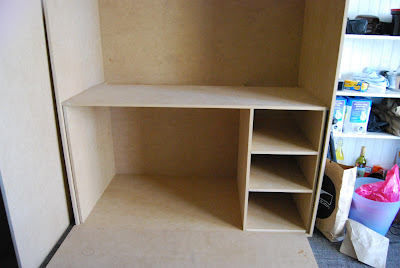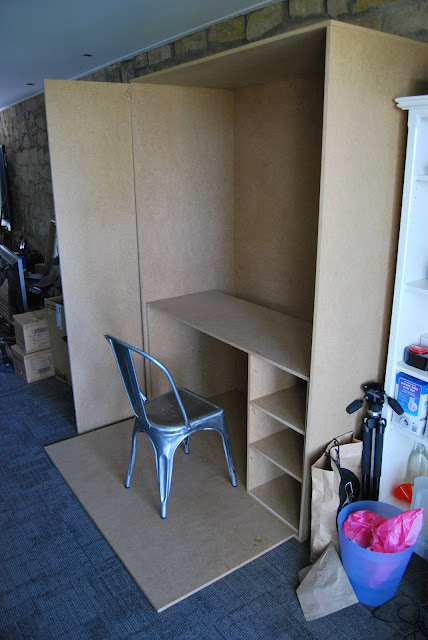And so the most frustrating part of the project continues. Painting.
When I first had the 'dry fit', putting the modules together to see if they fit, they did. Oh, they fit well - to within a fraction of a millimetre.
I then needed to undercoat the thing, and I decided to do it in modules (i.e. disassembled) so I could get at the more fiddly areas. Well, that was a mistake.
When I tried to reassemble it, it didn't fit as well as I would have liked. I had to sand and scrape away layers of paint and MDF to get some things in, like this
It worked in the end, but I should have just assembled it fully, and then painted it.
Anyway, other things were happening too, such as preparing to drill the air-out vent hole
 |
| Old cheap russian gas mask + HEPA filter = win |
 |
| This is one of the two fans I'm going to use. |
 |
| And the door! It works! |
 |
This is part of the baffle for the air-out vent
|
With the air-out vent (last two photos) the bit on the table is put in the thing above the door (the drying cabinet, where film hangs up to dry in the airstream). However, paint has made it a tight fit, meaning that it's almost certainly a one-installation job, with no ability to remove and fix it. That means that I'm going to need to undercoat it, and then paint it black where it is now, then install it.
Also, I haven't got a photo of it, but the air in module has an issue: It's stuck. I undercoated it and screwed it in place, however the undercoat is a bit sticky. Thus, its stuck and wont come down, which means I'm going to have to deal with two issues: 1. Painting the inside black to minimise reflections of light; and 2. Putting the fan inside it.
For 1: Solved. Because it has airflow through it, and because its undercoated, I can just spray black spraypaint through it, and the whole thing should end up black on the inside.
For 2: Solved. Instead of having the fan on the inside, it's going to be mounted on the outside, with the air HEPA filter on top of the fan - it's a fan sandwich. I've played around with them, and it will work. It might look a bit odd, though; but I'll paint it black on the outside so it looks less conspicuous. I'm actually thinking of painting the whole thing black on it's outside, so it looks a bit more subtle. If possible. It's not exactly going to look pretty on the outside, I've recently realised (especially when the dark cloth thing folds up as the door closes), so why not go with the flow?
More to come soon. It's going to be complete within several weeks.


























